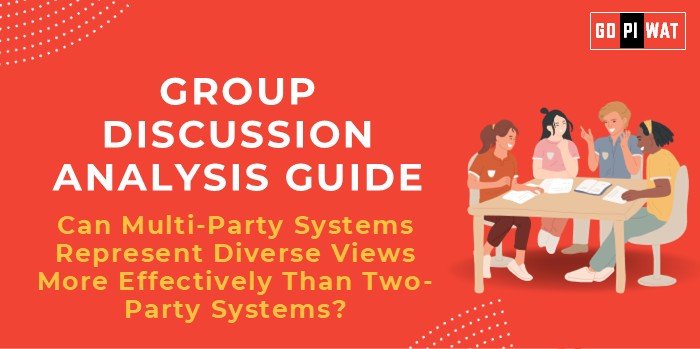📋 Group Discussion (GD) Analysis Guide: Can Multi-Party Systems Represent Diverse Views More Effectively Than Two-Party Systems?
🌐 Introduction to the Topic
- 🌍 Opening Context: In governance systems worldwide, the debate between multi-party and two-party systems remains central to political discourse, shaping the representational and functional aspects of democracy.
- 📜 Topic Background: While multi-party systems dominate countries like India and Germany, two-party systems define politics in the United States and the United Kingdom. Each system offers distinct approaches to governance, coalition-building, and representation of diverse perspectives.
📊 Quick Facts and Key Statistics
- 📈 India’s Political Parties: Over 2,800 registered political parties ensure representation for diverse regional and ideological groups.
- 🏛️ US System: Republicans and Democrats collectively represent 98% of Congressional seats, showcasing centralized political power.
- 📊 Voter Turnout Comparison: Multi-party democracies like Germany (76%) often show higher engagement than two-party systems like the US (66%).
- 🤝 Coalition Governance: 85% of governments in multi-party systems involve coalitions, enabling broader consensus.
🏛️ Stakeholders and Their Roles
- 👥 Citizens: Advocate for representation of local and ideological issues.
- 🏢 Political Parties: Frame policies reflecting diverse or concentrated viewpoints.
- 🌍 Governments: Ensure stability in coalition systems or streamlined policies in two-party setups.
- ⚖️ Election Commissions: Oversee fair representation processes.
🏆 Achievements and Challenges
✨ Achievements:
- 🌐 Multi-party System:
- ✅ Enables inclusive representation, seen in India with regional parties addressing specific state issues.
- 📊 Greater voter choice, reflected in nations like Germany, with proportional representation ensuring every vote counts.
- 🌍 Two-party System:
- ✅ Simplifies decision-making processes, reducing gridlocks seen in coalition governments.
- 📜 Strong policy continuity, as witnessed in the US over successive administrations.
⚠️ Challenges:
- 🌐 Multi-party Systems:
- ⚠️ Political instability due to coalition breakdowns (e.g., Italy’s frequent government changes).
- 📉 Fragmentation of votes, sometimes leading to inefficiency.
- 🌍 Two-party Systems:
- ⚠️ Limited representation, with minority or fringe issues often overlooked.
- 📉 Polarization, as seen in the US political climate.
🌍 Global Comparisons:
- 🇩🇪 Germany (Multi-party): Successfully balances diverse views with coalition governance.
- 🇺🇸 US (Two-party): Demonstrates stability but faces criticism for lack of representation.
📖 Case Studies:
- 🇮🇳 India’s Coalition Era (1996-1999): Political instability due to fragmented mandates.
- 🇬🇧 UK’s Coalition (2010-2015): Demonstrated successful coalition governance within a two-party tradition.
💬 Structured Arguments for Discussion
- ✅ Supporting Stance: “Multi-party systems better capture diverse viewpoints, enabling nuanced representation of regional, cultural, and ideological differences.”
- ❌ Opposing Stance: “Two-party systems ensure political stability and reduce policy gridlocks, fostering decisive governance.”
- ⚖️ Balanced Perspective: “While multi-party systems enhance representation, two-party systems provide stability; an ideal system might balance inclusivity with functionality.”
💡 Effective Discussion Approaches
- 🎯 Opening Approaches:
- 🌍 Highlight global contrasts: “Germany and the US exemplify the extremes of political representation—each with unique merits.”
- 📊 Cite data: “India’s multi-party democracy features over 2,800 registered parties, a stark contrast to the US’s centralized structure.”
- 🛡️ Counter-Argument Handling:
- 🌟 For instability: “Coalitions can lead to progress with the right frameworks, as seen in Germany.”
- 📈 Against polarization: “Increased voter turnout in multi-party systems shows their appeal to broader electorates.”
📌 Strategic Analysis of Strengths and Weaknesses
- 🌟 Strengths: Diverse representation, balanced ideologies.
- ⚠️ Weaknesses: Policy instability in coalitions.
- 🌟 Opportunities: Global examples to refine systems.
- ⚠️ Threats: Voter fatigue and fragmentation.
📚 Connecting with B-School Applications
- 💼 Real-World Applications: Project themes on electoral systems, coalition governance, or polarization management.
- 🗨️ Sample Interview Questions:
- 🌍 “Which governance system better suits a developing economy, and why?”
- 📈 “How do coalition governments affect fiscal policies?”
- 📖 Insights for B-School Students:
- 📚 Explore diverse governance models for strategic decision-making.
- 🔍 Analyze voter behavior in fragmented systems.


